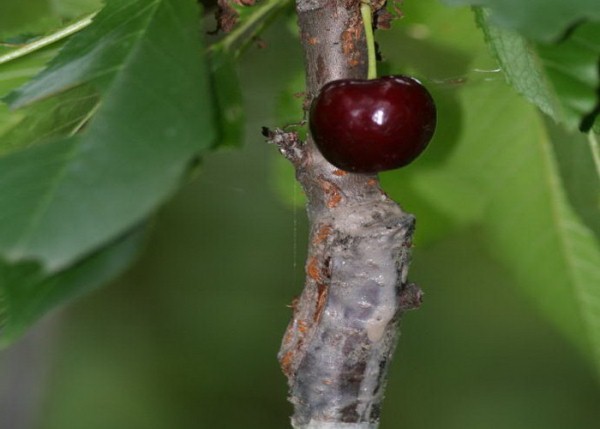Cherry is perhaps the most traditional culture in Russian gardens. It exists many varieties - both old-fashioned, national selection, and modern. The times of noble nests and Chekhov's cherry orchards have sunk into oblivion. On small, as a rule, land plots, a modern gardener should try to fit other fruit trees. And yet there is a way to have a whole collection of varieties of cherries - vaccination.
Vaccination refers to the vegetative methods of plant reproduction. Its use can help out if:
- old variety does not suit, and I want to replace it, without wasting time on growing from a sapling;
- got sambozplodny grade - planted cherry blossoms, but does not set fruit;
- some the tree in the garden brokebut the root remained alive;
- I want to have several different varietiesbut the plot area is too small.
Table of contents
What can be planted cherry
Even novice fruit growers have heard the terms “graft” and “stock”. The stock is a plantto be vaccinated. Graft - Stalk or the axillary bud of the plant to be grafted.
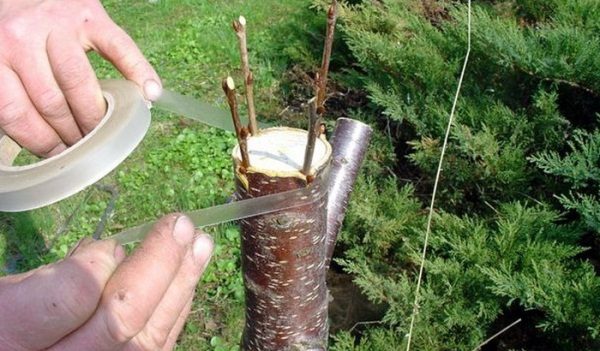
The procedure always begins with the choice of stock. Not only the productivity of the tree, but also the size and taste of the fruit depends on it. The first thing you notice is plant compatibility. Here is a simple rule: the closer the relationship, the better.
Cherry compatibility with different rootstocks
| Rootstock | Compatibility degree | Special features |
|---|---|---|
| Wild cherry | Very high | One of the best stock options.To get a seedling of wild cherry is not difficult, and the risk of rejection of the graft is minimal. The plant receives from the rootstock endurance and adaptability to climatic conditions, but can give root growth. |
| Cherry cultivar | Very high | A great option for growing several varieties on a common trunk. But in this case, you need to make sure that the timing of flowering varieties coincide. |
| Bird cherry | High | A graft is almost always perfectly acclimatized on the cheremukhov stock. Such manipulation is especially beneficial in the northern regions: the bird cherry reports to the cherry frost resistance and disease resistance. |
| Plum | High | As a stock, it is better to take half-wild seedlings, but you can plant a cherry on a varietal plum growing in the garden. |
| The turn | Good | Very good, but a little uncomfortable stock for cherry. The turn throws a lot of root offspring, and to deal with them is quite troublesome. |
| Cherry plum | Good | Universal rootstock for stone fruit. Good for its exceptional stamina. |
Some fruit growers experimenters try themselves in the role of Michurin and try to plant a cherry on an apple or pear tree. Indeed, these plants belong to the same botanical family - Pink.However, the relationship between them is "cousin." Apple trees and pears - from the subfamily Apple trees (popularly called "pome"), and cherry and sweet cherry - from the subfamily Plum ("Stone"). Therefore, such a transplant will not lead to success.
When to vaccinate, spring or summer?
The optimal duration of the operation is dictated by the physiology of the plant.. Inexperienced “transplantologists” is better to choose the time before the start of sap flow - the early spring. This is due to a small nuance: if a little late, the juice in the slices will oxidize, which will prevent the cutting or kidney from taking.
You can graft cherries later. Inoculations with green cuttings are quite successfully practiced in the summer.. However, firstly, they should be performed very quickly and clearly, to prevent the formation of an oxide film. It requires manual dexterity and skill. Secondly, it is important to choose the right weather and not to delay the procedure until the end of the summer.
Where to get cuttings for vaccination
It is usually advised to harvest the cuttings of cherries in the fall, after the fall of the leaves, before the arrival of frost.However, preserving them until spring is a difficult task for novice gardeners. It is necessary to ensure such conditions that the twigs remain moderately wet, but not rotted; they didn’t freeze, but they didn’t wake up too soon. To save yourself from these worries, there are two ways: buy a graft in the garden center or cut it yourself in the spring.
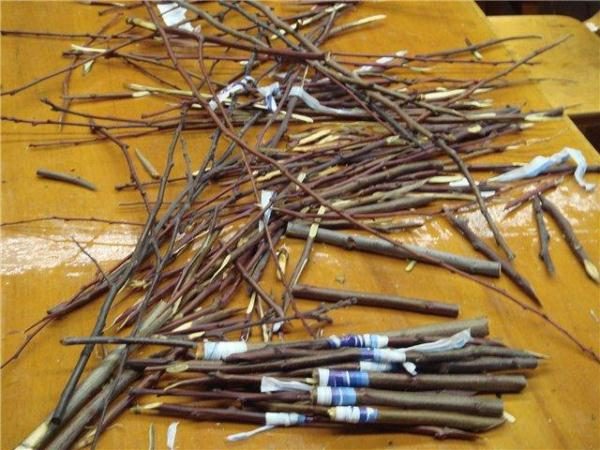
In nurseries there are special rooms where cuttings are stored at optimum temperature and humidity. Before vaccination, you will only need to refresh sections. An economical option: buy one cutting and remove several holes from it.
You can cut the material yourself by agreeing with your neighbors or relatives. According to the experience of many gardeners, grafting with fresh cuttings is often more successful than the “autumn” ones, even those kept in ideal conditions..
In the spring harvest the cuttings of cherries like this:
- Examine the uterine plant and choose a good shoot last year's growthbut. It is easy to distinguish them: the bark on them is reddish, thin, glossy and shiny.
- Check to there were only leafy (pointed) buds on the shoot. The fact is that cherry fruits most often at last year's increments, so they can be laid flower (rounded) buds.
- Cut the escape with shears, remove the apical bud and cut into “pencils” 25–30 cm long. There should be 3-4 buds on each handle.
Harvested material can be wrapped in wet gauze to prevent cuttings from drying out.
An overview of the basic methods of grafting cherries
Garden "surgeons" have developed a lot of methods of vaccination. The most simple and affordable for beginners. - budding, simple copulation and graft splitting.
Cherry budding: procedure
The essence of the method is the transfer of the axillary bud of the cherry to the stock. The grafting material is called the “peephole”. For the operation, you will need a perfectly sharp, clean knife (you can use a clerical, but it is desirable to have an okulirovochny) and PVC tape. It is better to cut off the eyes immediately before the procedure..
- A good kidney is selected on the handle.. It must be cut along with part of the bark (shield). The length of the shield is about 2 cm. The inoculum is placed on a clean, damp cloth so that the cut does not dry out.
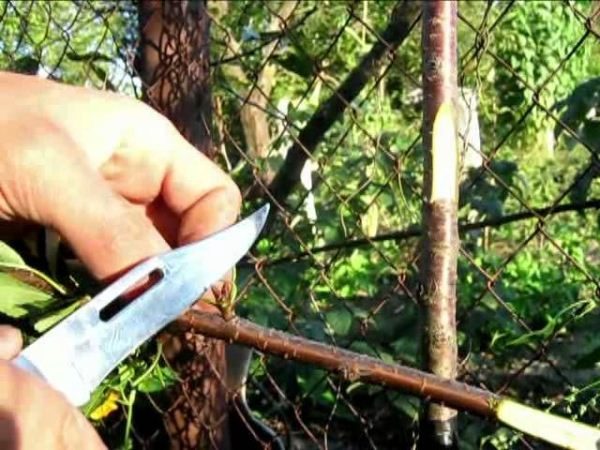
- On the selected part of the stock the knife makes a T-shaped incision on the bark.
- The notch flaps gently move away, the peephole is inserted and pressed tightly by the flaps on top so that only the kidney is looking out.
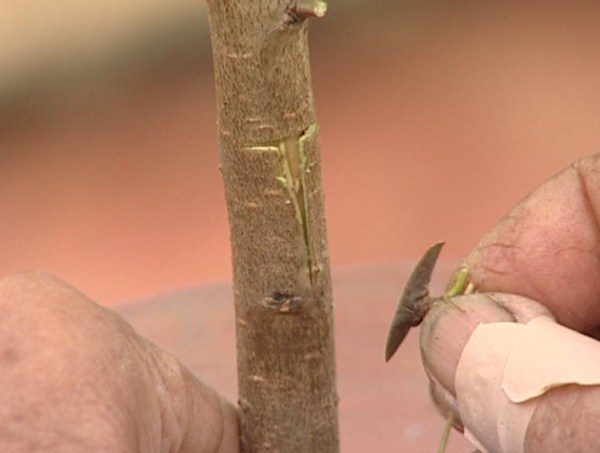
- Construction wrapped reverse side of the tape, so that when removing it, the bark is not torn.

Some gardeners, fearing the return of spring frosts, create around the grafts of plastic bags. Here you need to weigh everything well. The risk of “boiling” your vaccine under the active sun may be higher than the risk of freezing it..
Budding is the least traumatic method of vaccination. Even if something goes wrong and the eye does not take root, the plant will quickly tighten a small superficial wound.
Graft Splitting
This method is not only simple, but also gives the highest percentage of survival. According to the observations of gardeners, out of every ten vaccinations in the split is taken nine.
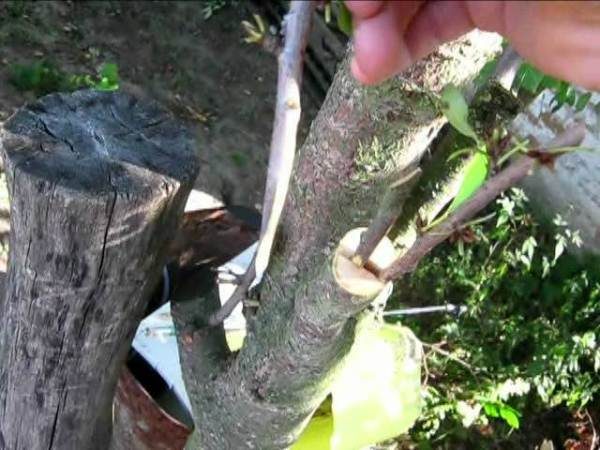
Unlike budding, here the whole cutting is a graft material. From the tools you need pruner or garden file, sharp clean knife (copulation is better, but you can get along with the usual one), electrical tape and garden pitch.
- Preparing the stalk with 3-4 good kidneys. Its lower end is cut with a knife on a double wedge. The length of the slice should be three times the thickness of the shoot. The handle is wrapped in a damp, clean cloth.
- If the diameter of the stock is large, an even cut is made to the desired height. If the graft and stock are approximately equal in thickness, a secateur is used.
- A knife is put along the line of the diameter of the saw cut, and an incision is made to a depth of 3 or 4 cm. To split did not close, you can insert into it a temporary spacer-peg.
- The handle is slit to the depth. If the stock is selected thick, it is necessary to insert a cutting at the very edge, so that the bark coincides with the bark, and the cambium with the cambium. If there is a possibility, it is possible to start two grafts in one split at a time - from two edges.
- The stock is firmly wrapped in a spiral with the reverse side of the tape. It is important to ensure a perfect fit of all graft tissues and rootstocks.
- The end area of the cleaved hermetically plastered with garden pitch. Tops of the cuttings are also processed.
Easy copying
This method is suitable for matching the diameter of the stock and the scion. For work, you will need a pruner, a copulation or a regular sharp knife, electrical tape and a device for correcting the cut angle. The latter can be easily done by hand. A metal or plastic tube of small diameter is cut at an acute angle (about 30⁰) - and ready. The vaccination is performed according to the following scheme:
- The shank is inserted into the tube so that its lower end peeks out a little.
- A knife cut is done exactly along the cutting line of the tube.
- The stock is shortened by pruning shears to the desired height.. A tube is put on it and a similar cut is made.
- The stalk is applied to the stock cut to the cut. All fabrics must be completely matched.
- Junction firmly wrapped with tape.
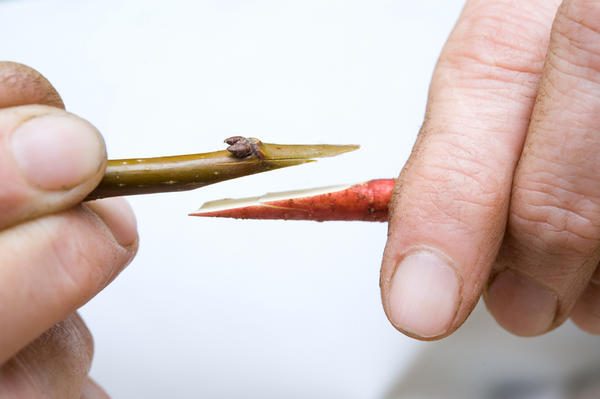
Simple copulation is good for its simplicity and a good percentage of survival. But it has a drawback: insufficient strength in the place of accretion. Cherry has brittle wood, and the strength of the connection with the stock is extremely important during the grafting. In this sense, the budding method is much more reliable.
Vaccinated or not vaccine becomes visible in a week or two. If the kidneys start to grow, then the material takes root normally.. Remove the tape is not necessary. In the coming year, a callus influx will form in the place of accretion - a thickening similar to a corn. Next spring, it will be possible to remove the remnants of electrical tape and wait for crops.
Grafting a cherry is a fascinating occupation, akin to a scientific experiment. It gives a lot of room for creativity and even a novice gardener.
